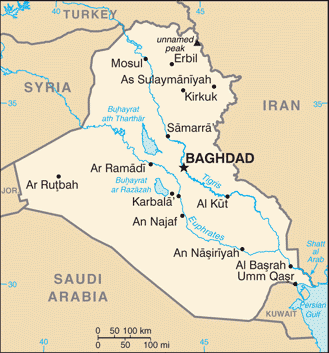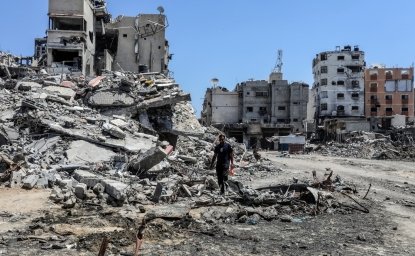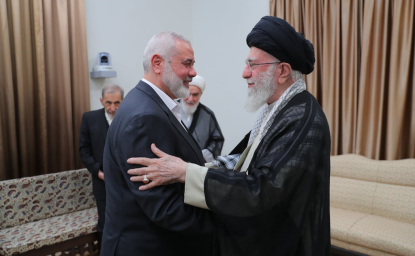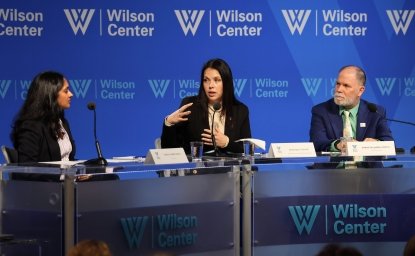July 28, 1971 – Ibrahim Awwad Ibrahim al Badri was born in al Jallam, a small village in central Iraq. He was raised in a devout Sunni family that claimed descent from the Prophet Mohammed. The family moved to Samarra when he was a young child.
1991 – Al Badri enrolled in the Shariah college of the University of Baghdad.
1996 – Al Badri graduated from the University of Baghdad. He then enrolled at the Saddam University for Islamic Studies to study Koranic recitation.

1999 – Al Badri graduated with a master’s degree in Koranic recitation and enrolled in a doctoral program in Quranic sciences. He taught classes at al Jah Zaidan Mosque to pay for school.
2003 – Al Badri joined a local resistance movement after U.S. and coalition forces invaded Iraq. He started going by the nom de guerre, Abu Dua.
January 2004 – U.S. forces swept up Abu Dua in a raid near Falluja that targeted his brother-in-law. He was processed and detained at Camp Bucca. At the camp, he befriended members of al-Qaeda in Iraq (AQI).
December 8, 2004 – Abu Dua was released from Camp Bucca and connected to AQI through a family relative. He traveled to Damascus and worked on aligning the group’s online propaganda with Salafi-Jihadist ultraorthodoxy.
March 13, 2007 –Abu Dua returned to Baghdad and defended his doctorate dissertation in Quranic Sciences. He earned his Ph.D. with a grade of “very good.”
2007-2010 – Abu Dua rose the ranks of AQI which rebranded as the Islamic State of Iraq (ISI). He joined the group’s Sharia Committee and rose to the number three position as ISI’s top spiritual advisor.

April 18, 2010 – The top two ISI commanders died in a raid by U.S. and Iraqi forces outside Tikrit.
May 16, 2010 – ISI’s Shura Council elected Abu Dua as its emir in a nine-to-two vote. He adopted a new nom de guerre, Abu Bakr al Baghdadi.
2010-2013 – Iraqi security forces tried and failed to arrest Baghdadi at least six times.
August 2011 – Baghdadi sent an operative to set up an ISI branch in Syria. The group, Jabhat al Nusra, became a rival to Baghdadi’s group.
April 2013 – Baghdadi attempted to merge al-Nusra with ISI, but the Syrian offshoot pledged allegiance to al Qaeda’s Ayman al Zawahiri instead. Breakaway elements of al Nusra joined with Baghdadi to form the Islamic State of Iraq and Syria (ISIS).
Late 2013 – Fighters from ISIS and al Nusra fought one another in Syria. Zawahiri failed to negotiate a compromise between the two groups.
February 2014 – Zawahiri expelled ISIS from al Qaeda.
February 2014-June 2014 – ISIS seized territory from al Nusra and other rebel Islamist factions to become the dominant jihadist faction in Syria.
June 10, 2014 – ISIS routed Iraqi Security Forces and seized control of Mosul, Iraq.
July 4, 2014 – Baghdadi ascended the pulpit of the Grand Mosque in Mosul and declared himself the caliph of the Islamic State.
November 13, 2014 – ISIS released an audiotape of Baghdadi after reports he had been killed or injured in a U.S. airstrike.
March 18, 2015 – An airstrike in the Nineveh province of Iraq seriously wounded Baghdadi but failed to kill him.
May 14, 2015 – Baghdadi urged Muslims to emigrate to the Iraq and Syria in an audiotape released by ISIS. The tape mentioned the conflict in Yemen just seven weeks after the start of the Saudi-led coalition’s aerial campaign.
December 26, 2015 – Baghdadi threatened to establish an ISIS branch in the Palestinian territory in an audiotape released by ISIS.
October 2016 – Baghdadi was spotted several times in the town of al-Bukamal on the Iraq-Syria border.
November 2, 2016 – Baghdadi urged followers in an audiotape to fight to the death against coalition forces attacking Mosul, Iraq.
June 16, 2017 – Moscow said it had “high probability” a Russian airstrike near Raqqa killed Baghdadi.
September 1, 2017 – The counter-ISIL coalition said Baghdadi was probably still alive.
September 28, 2017 – Baghdadi released his first audiotape since the liberation of Mosul. He referenced developments in the Syria peace process and North Korean nuclear threats against the United States.
July 4, 2018 – Baghdadi’s son was killed fighting Syrian government forces in Homs, according to ISIS.
August 23, 2018 – Baghdadi urged followers to “persevere” in the fact of losses in Iraq and Syria. He referenced the detention of Pastor Andrew Brunson by Turkey.
April 23, 2019 – Baghdadi appeared in a video for the first time in five years. He acknowledged ISIS’s defeat at Baghuz, Syria, and referenced the Easter Sunday terrorist attack in Sri Lanka.
September 16, 2019 – Baghdadi urged followers in an audiotape to free detained ISIS members held in prison camps in Iraq and Syria.
October 26, 2019 – Baghdadi died during a U.S. special operations raid in Idlib, Syria.
October 31, 2019 – ISIS confirmed Baghdadi’s death and names his successor, Ibrahim al Hashemi al Qurayshi.
Andrew Hanna, a research assistant at the U.S. Institute of Peace, contributed to this timeline. Sources include reporting by The New York Times, The Washington Post and a report by The Brookings Institution.

The Islamists
Learn more about Hamas and how it relates to similarly aligned organizations throughout the region. Read more

Explore More
Browse Insights & Analysis
Israel Escalates Attacks in Gaza: What’s Next?

Israel Expands Operations on Multiple Fronts: Perspectives on the Conflict

